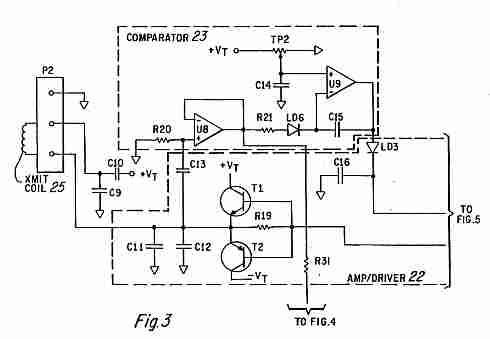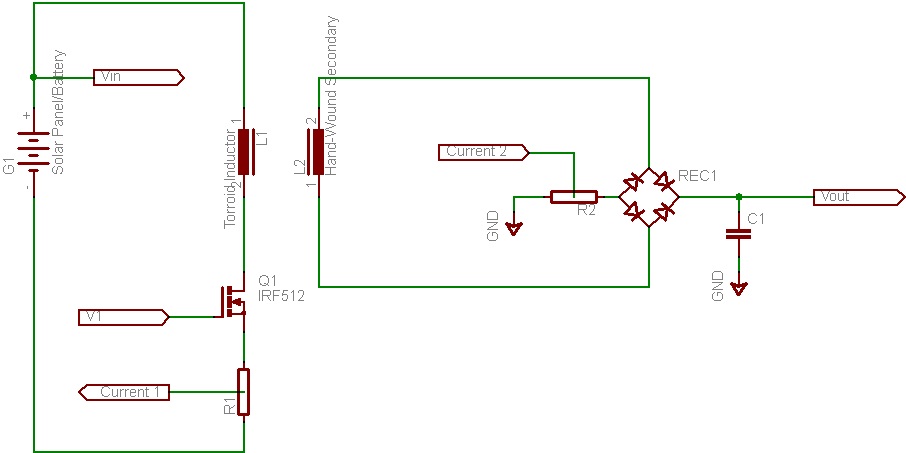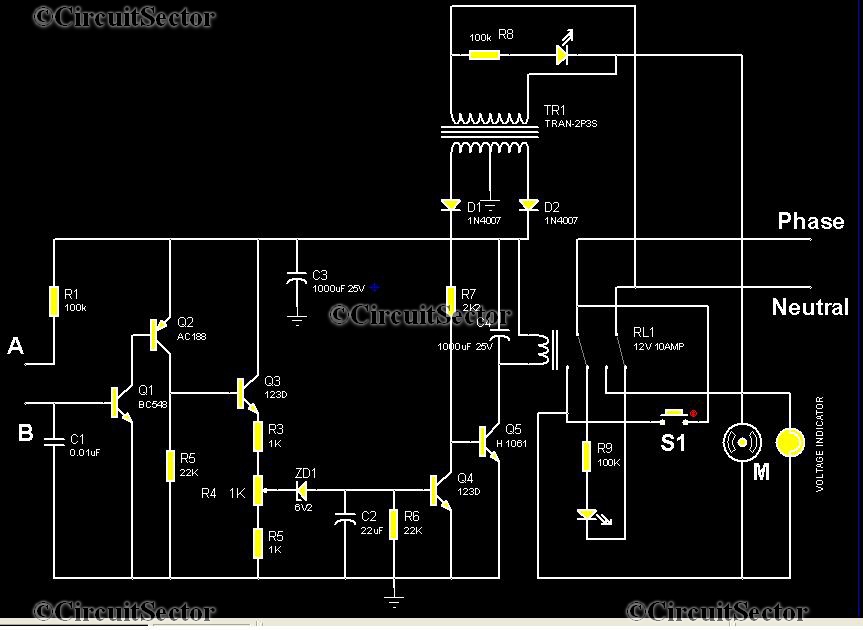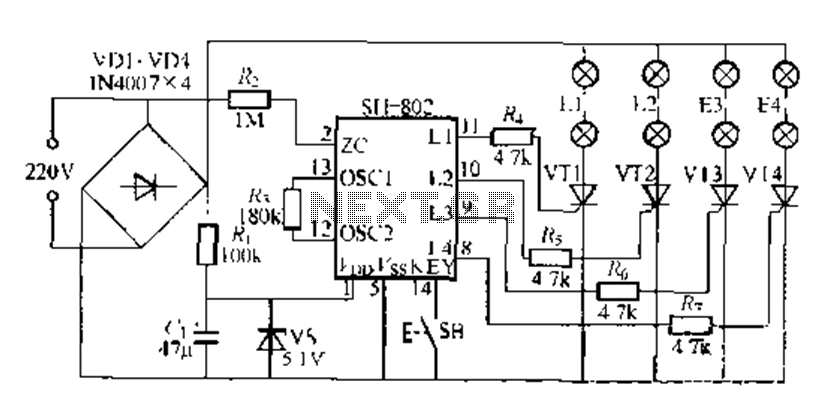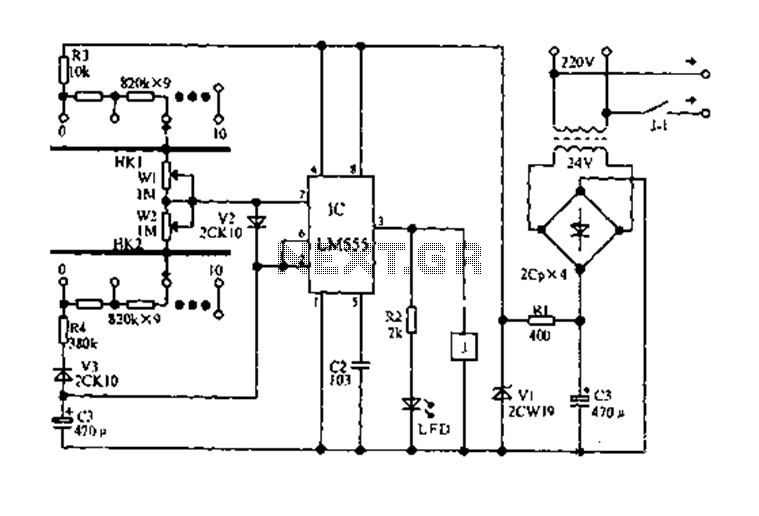
counter down timer circuit

This circuit is designed as a countdown timer utilizing a countdown calculation. It employs the 555 integrated circuit (IC) as the primary control element. The 555 IC functions as a counter and a transistor switch to activate a relay in either ON or OFF mode, as selected by a jumper, upon completion of the counting period. The circuit comprises an oscillator, a ripple counter, and two switching transistors. The 555 is configured in a standard astable oscillator circuit to generate a square wave cycle with a period of approximately 1 cycle per second. The output pulse from pin 3 of the 555 feeds into the clock input pin 10 of a 14-stage binary ripple counter, the 4020 (or 14020). The operation of the circuit is elaborated in the following description. In this circuit, C3, R4, and D1 are arranged to function as a power-on reset mechanism. When power is applied, C3 is initially in a discharged state, causing pin 11 to be pulled high. C3 charges quickly through R4, resulting in a drop in the voltage at pin 11, which enables the counter. The 14020 counts clock pulses until the selected counter output goes high. D1 provides a discharge path for C3 when power is disconnected. The component values of R1 and C1 can be adjusted to set the 555 count frequency to greater than 1.0 Hz. For a count of 10 seconds, a maximum timer delay of 81,920 seconds, or 22.7 hours, can be achieved. The output from the 4020 connects to a transistor switch arrangement. Two BC547 transistors are configured to allow either switching option for the relay. A jumper determines the selected option. The relay can either turn ON when power and counting commence and turn OFF after the counting period, or it can do the opposite, turning ON after the counting period ends and remaining ON as long as power is supplied. It is important to note that the reset pin of the 555 is connected to the collector of Q1, which enables the 555 during counting as the collector of Q1 is pulled low.
This countdown timer circuit effectively combines the functionality of a 555 timer IC and a 14-stage binary ripple counter to create a versatile timing solution. The 555 timer is configured in astable mode, generating a consistent square wave output that serves as the clock signal for the 4020 counter. The choice of the 4020 counter allows for a broad range of timing applications, as it can count up to 16,384 clock cycles, translating to significant time delays when configured correctly.
The power-on reset circuit, consisting of capacitor C3 and resistor R4, ensures that the counter begins in a known state upon power-up. The diode D1 plays a crucial role in discharging C3 when the circuit is powered down, preventing any unwanted counts during subsequent power cycles. This feature enhances the reliability of the timer.
Adjustable resistors (R1) and capacitors (C1) provide flexibility in setting the timing intervals, allowing for customization based on specific application requirements. The configuration of the BC547 transistors facilitates the relay operation, providing the ability to select between different relay action modes via a jumper. This adaptability makes the circuit suitable for various applications, including automated control systems, timers for household appliances, and industrial timing solutions.
Overall, the design integrates fundamental electronic components to achieve a functional and adjustable countdown timer, demonstrating the versatility and utility of the 555 timer and binary counters in practical applications.This circuit is design of the counter timer that using countdown calculation. This circuit is using 555 IC as main control. 555 IC is a counter IC and a transistor switch to activate a relay either ON/OFF (mode selected by a jumper) as soon as the counting period is over. The circuit consists of an oscillator, a ripple counter and two switching tr ansistors. This is the figure of the project circuit. The 555 is configured in the standard astable oscillator circuit designed to give a square wave cycle at a period of around 1 cycle/sec. The output pulse from pin 3 of the 555 is fed to the clock input pin 10 of the 14-stage binary ripple counter, the 4020 (or 14020.
) Operation of the circuit is explained in next. In this circuit C3, R4 and D1 are arranged as a power-on reset. When power is applied to the circuit C3 is in a discharged state so pin 11 will be pulled high. C3 will quickly charge via R4 and the level at pin 11 falls thus enabling the counter. The 14020 then counts clock pulses until the selected counter output goes high. D1 provides a discharge path for C3 when the power is disconnected. You can change the components values of R1 and C1 to set the 555 count frequency to more than 1. 0 Hz. If you change the count to 10 seconds then a maximum timer delay of 81920 seconds, or 22. 7 hours, can be obtained. The output from the 4020 goes to a transistor switch arrangement. Two BC547 are connected so that either switching option for the relay is available. A jumper sets the option. The relay can turn ON when power and counting start then turn OFF after the count period, or it can do the opposite. The relay will turn ON after the end of the count period and stay on so long as power is supplied to the circuit.
Note that the reset pin of the 555 is connected to the collector of Q1. This enables the 555 during the counting as the collector of Q1 is pulled low. 🔗 External reference
This countdown timer circuit effectively combines the functionality of a 555 timer IC and a 14-stage binary ripple counter to create a versatile timing solution. The 555 timer is configured in astable mode, generating a consistent square wave output that serves as the clock signal for the 4020 counter. The choice of the 4020 counter allows for a broad range of timing applications, as it can count up to 16,384 clock cycles, translating to significant time delays when configured correctly.
The power-on reset circuit, consisting of capacitor C3 and resistor R4, ensures that the counter begins in a known state upon power-up. The diode D1 plays a crucial role in discharging C3 when the circuit is powered down, preventing any unwanted counts during subsequent power cycles. This feature enhances the reliability of the timer.
Adjustable resistors (R1) and capacitors (C1) provide flexibility in setting the timing intervals, allowing for customization based on specific application requirements. The configuration of the BC547 transistors facilitates the relay operation, providing the ability to select between different relay action modes via a jumper. This adaptability makes the circuit suitable for various applications, including automated control systems, timers for household appliances, and industrial timing solutions.
Overall, the design integrates fundamental electronic components to achieve a functional and adjustable countdown timer, demonstrating the versatility and utility of the 555 timer and binary counters in practical applications.This circuit is design of the counter timer that using countdown calculation. This circuit is using 555 IC as main control. 555 IC is a counter IC and a transistor switch to activate a relay either ON/OFF (mode selected by a jumper) as soon as the counting period is over. The circuit consists of an oscillator, a ripple counter and two switching tr ansistors. This is the figure of the project circuit. The 555 is configured in the standard astable oscillator circuit designed to give a square wave cycle at a period of around 1 cycle/sec. The output pulse from pin 3 of the 555 is fed to the clock input pin 10 of the 14-stage binary ripple counter, the 4020 (or 14020.
) Operation of the circuit is explained in next. In this circuit C3, R4 and D1 are arranged as a power-on reset. When power is applied to the circuit C3 is in a discharged state so pin 11 will be pulled high. C3 will quickly charge via R4 and the level at pin 11 falls thus enabling the counter. The 14020 then counts clock pulses until the selected counter output goes high. D1 provides a discharge path for C3 when the power is disconnected. You can change the components values of R1 and C1 to set the 555 count frequency to more than 1. 0 Hz. If you change the count to 10 seconds then a maximum timer delay of 81920 seconds, or 22. 7 hours, can be obtained. The output from the 4020 goes to a transistor switch arrangement. Two BC547 are connected so that either switching option for the relay is available. A jumper sets the option. The relay can turn ON when power and counting start then turn OFF after the count period, or it can do the opposite. The relay will turn ON after the end of the count period and stay on so long as power is supplied to the circuit.
Note that the reset pin of the 555 is connected to the collector of Q1. This enables the 555 during the counting as the collector of Q1 is pulled low. 🔗 External reference
